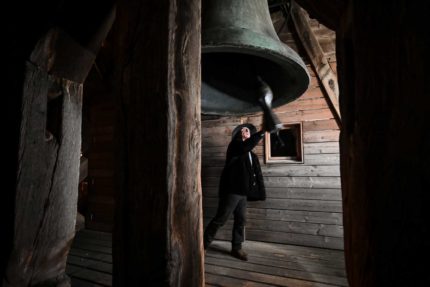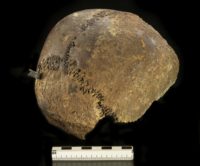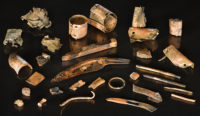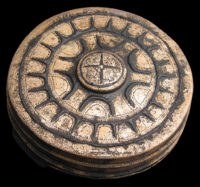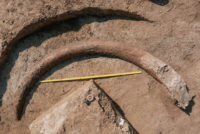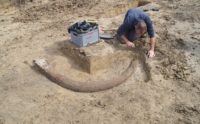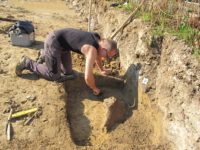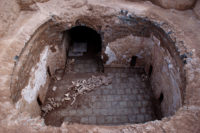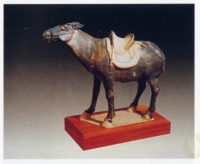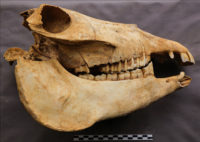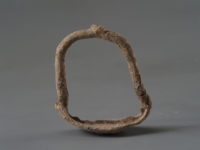 A massive hoard of 1,753 Roman silver coins left behind by Vandals fleeing the invading Goths has been found in southeastern Poland. The coins were discovered last year by farmer Mariusz Dyl while he searched for antlers in a field outside Cichobórz, a village 8 miles south of Hrubieszów near the border with Ukraine. They were scattered over a large area. Dyl collected what he could and then reported the find to archaeologists at the Hrubieszów Museum.
A massive hoard of 1,753 Roman silver coins left behind by Vandals fleeing the invading Goths has been found in southeastern Poland. The coins were discovered last year by farmer Mariusz Dyl while he searched for antlers in a field outside Cichobórz, a village 8 miles south of Hrubieszów near the border with Ukraine. They were scattered over a large area. Dyl collected what he could and then reported the find to archaeologists at the Hrubieszów Museum.
Aided by Mr. Dyl, a team of archaeologists excavated the area and unearthed another 137 denarii up to 100 meters away from what they believed to be the original burial spot. That’s where the finder discovered the largest grouping of coins. Eight silver-plated bronze rivets were found amidst the coins there, likely the surviving remains of a wood or leather container they were buried in.
The coins are silver denarii from the 1st and 2nd centuries AD, the reigns of the emperors Nerva (r. September 18, 69 A.D. – January 27, 98 A.D.) and Septimius Severus (193-211 A.D.), indicating the hoard was buried in the late 2nd or early 3rd century. They weigh more than 12 pounds (5.5 kilos) in total, making it by far the largest Roman treasure found in the Lublin province and one of the largest ever found in Poland.
When those coins were in circulation, the Hrubieszów area was inhabited by Vandals, eastern Germanic peoples who in the late 1st century allied with Rome against opposing Germanic tribes. Cassius Dio, who like Tacitus called them Lugii, wrote in Roman History that Domitian sent them 100 horses in support of their fight against the Suebi, the first recorded appearance of Roman troops in what is now Poland. In the second half of the 2nd century, they fought with other Germanic tribes against the Roman Empire in the Marcomannic Wars, but in the last two decades of the century, pressure from the Goths moving south drove the Vandals west.
Archaeological material discovered in the Lublin region attest to what a dangerous time it was. There are a large number of Vandal cemeteries with warrior burials where the deceased was interred with ritually destroyed weapons.
Andrzej Kozłowski from the Archaeology Institute at the Maria Curie-Skłodowska University in Lublin believes that the buried treasure represents the last stand of the Vandals in the Lublin region.
“The situation was so bad for the Vandals retreating, or rather the fleeing from the Goths that they hid everything that was most precious,” he said.
“It seems that this is where the Vandals lost the means to continue fighting!” he added.
The archaeologist underlined how important the find is for understanding the downfall of the Vandals in the region.
“They had to get rid of huge financial resources that were necessary to wage war with the Goths, and therefore they ended up helpless. The hidden coins remained under Hrubieszów.
“They couldn’t come back for them and could not recruit soldiers. That is why the Goths peacefully spread to the whole south-east and occupied Ukraine,” he said.
 A Roman legionary at that time earned about 300 silver denarii a year, so the hoard constituted a vast sum for anyone even in the most expensive urban centers, geometrically more so for Germanic tribesmen at the outskirts of the empire.
A Roman legionary at that time earned about 300 silver denarii a year, so the hoard constituted a vast sum for anyone even in the most expensive urban centers, geometrically more so for Germanic tribesmen at the outskirts of the empire.
The hoard will now be conserved and examined by experts at the University of Warsaw. With so many coins to go through, the process is expected to take at least a year. The Hrubieszów Museum wants to put them on display, but given all our current givens, the hoard will be an online exhibition before visitors have the opportunity to see them in person.
